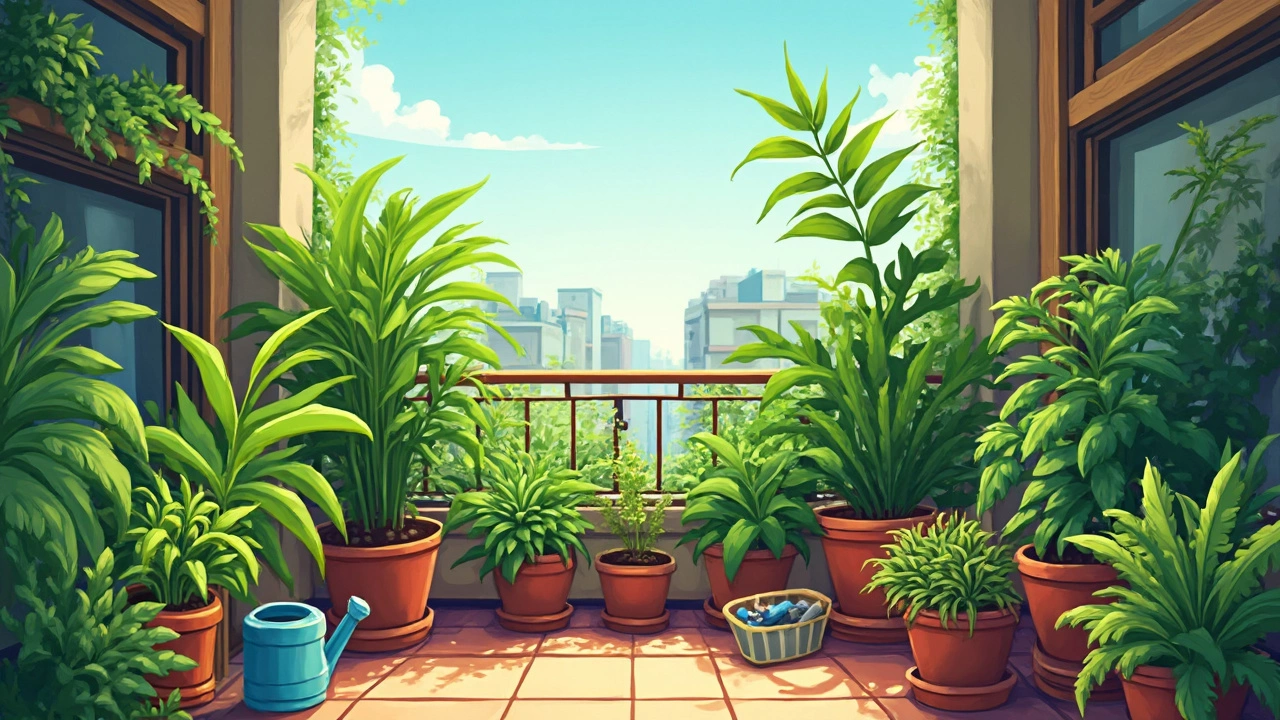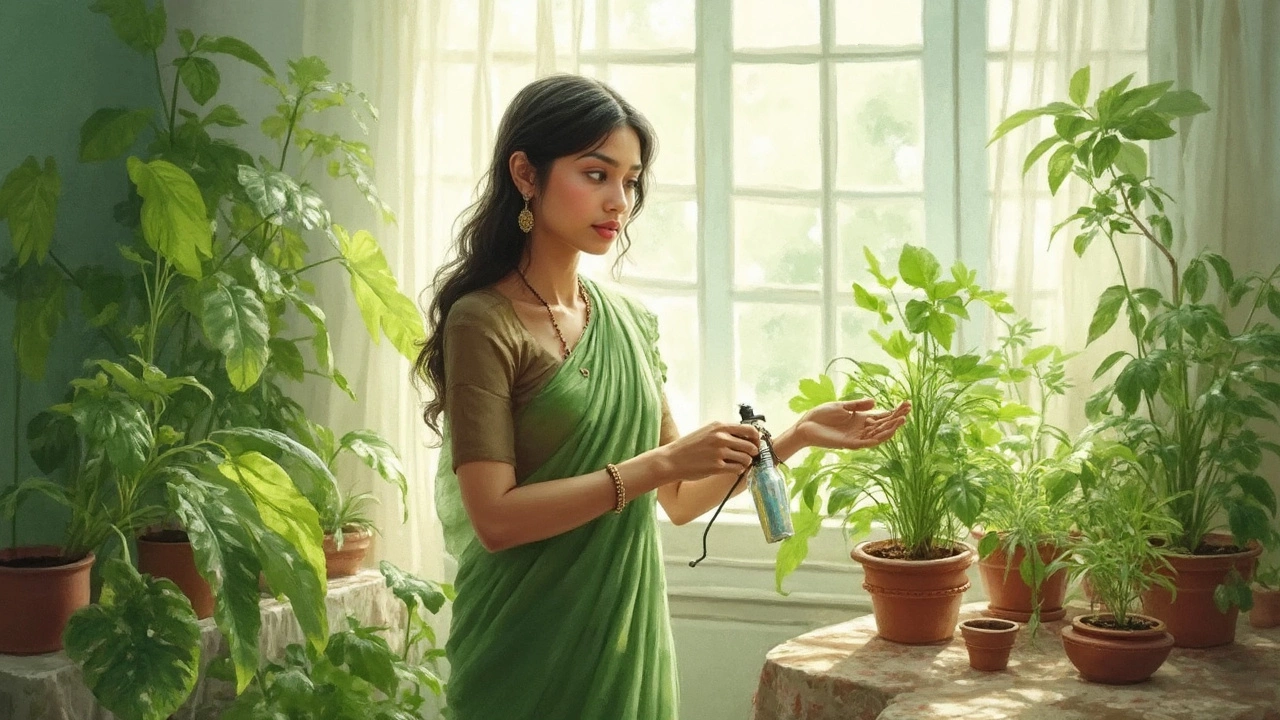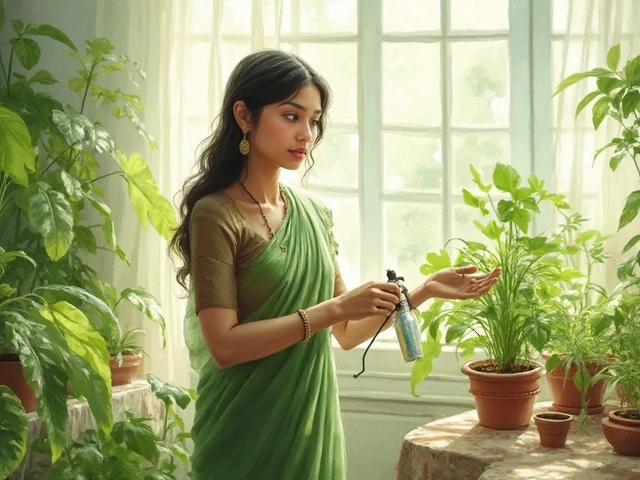Ever wondered why your neighbor's plants seem eternally happy while yours look gloomy? It could be down to how you're caring for them. One thing's for sure—the secret sauce for houseplants begins with the right amount of sunlight. Position them close to a window, but not too close if it gets intense midday sun. Think of favorite spots like east-facing windows where morning light is just right.
Then, there's the tricky part—watering. It's not just about splashing some water whenever you remember. Dip your finger an inch into the soil; if it feels dry, then it’s time for a drink. Too much love, and you'll drown them; too little, and they'll parch.
- Sunlight and Placement
- Watering Wisely
- Soil and Nutrition
- Temperature and Humidity
- Recognizing Signs of Distress
- Creating a Routine
Sunlight and Placement
Getting the sunlight right is like setting the stage for your plant's happy dance. Most indoor plants love indirect light, so think of placing them where sunlight streams through the curtains. An east-facing window usually works wonders by offering gentle morning rays without the scorching heat.
Not all plants have the same appetite for light. Succulents and cacti thrive in bright, sunny spots as they naturally bask in lots of light. On the other hand, ferns and peace lilies enjoy a more shaded spot, preferring low light conditions. It’s like a plant’s version of Goldilocks—finding that “just right” spot is key.
For many houseplants, rotating their pots routinely ensures they grow evenly rather than leaning desperately towards their light source. It’s also good to remember that artificial light can supplement natural light, especially during those long winter months.
If you really want to get your plant science on, consider using a light meter to check the brightness of room corners in terms of foot-candles or lux. This tool can offer insights into whether a spot is perfect or too dim. Here’s a little guideline:
- Low Light: 50-250 foot-candles
- Medium Light: 250-1000 foot-candles
- Bright Light: 1000-2000 foot-candles
However, if you're less techy, it just comes down to regularly checking how your plant reacts. Dark leaves or stretched, leggy growth usually means it’s too shady. Sunburn spots? That’s a cry for less exposure!
Watering Wisely
Ah, watering—the art form of indoor plants care. It sounds simple, right? Just splash some water and you’re done. But hold up. There’s more to it if you want a truly happy plant.
First off, frequency matters. Most plants do well when the top inch of soil feels dry—a little dryness tells them it's time for a drink. The key is not to overdo it. Excess water is like inviting trouble, leading to root rot which spells disaster for those lovely leaves.
Next, the watering technique matters too. Pour slowly and see if the water drains from the bottom of the pot. If it doesn’t, the soil might be too compact or you might have clogged drainage holes—both are no-gos for health.
Here’s a pro tip: use room temperature water. Cold water can shock plant roots, while hot water might actually damage them. Keep it comfy like a lukewarm bath.
- Check the soil regularly—get your finger dirty! It's the best moisture meter.
- Consider the type of plant. Succulents need less water than tropical plants, so adjust accordingly.
- Beware of the changing seasons; less sunlight in winter months often means less frequent watering.
If you’re a data-driven kind of person, grab a moisture meter from your local gardening store. Trust me, it’s a small investment for a whole lot of peace of mind.
Soil and Nutrition
Soil is like the home base for your indoor plants. Not all soil is created equal, though. Most houseplants flourish in a good potting mix that drains well. Avoid tossing them into garden soil, which can be too dense and might suffocate their roots.
Want a tip to make your houseplant feel extra special? Customize their soil to fit their needs. If you're growing succulents, go for something sandy. Need something for your leafy pals like ferns? They usually love a more moisture-retentive mix.
Nutrition’s another biggie. Plants need a balanced diet, just like we do. Fertilizers are plant food, and there are liquid ones for those who like the convenience or pellets for a slow release of nutrients. Spring and summer are prime feeding times, as this is their active growing phase. Come winter, you can ease off.
Here's a breakdown of what fertilizers generally contain:
| Nutrient | Purpose |
|---|---|
| Nitrogen | Promotes leaf growth |
| Phosphorus | Boosts root and flower development |
| Potassium | Helps build a strong plant structure |
The key is not to overdo it. Over-fertilizing can be as harmful as under-nourishing. Look out for scorched leaf edges; it's a sign you might be giving them too much.
Ultimately, the aim is to imitate a plant's natural environment. Think about it—would your favorite houseplant be happiest in a dry desert or a lush forest? Tailor the soil and food accordingly, and you'll have a thriving indoor jungle in no time!

Temperature and Humidity
When it comes to indoor plants care, temperature and humidity levels can be game-changers. Most houseplants are pretty chill with a comfortable range between 65°F to 75°F (18°C to 24°C). Anything too extreme, like a drafty spot or next to a heater, can cause your plant to sulk.
Humidity is another big deal, especially during winter when heaters dry out the air. Tropical plants, like ferns and orchids, crave humidity. Think of them as the spa lovers of the plant world. Aiming for around 50% humidity will keep them smiling—many plant parents use a humidifier or place a tray of water nearby to boost moisture levels.
For a more hands-on approach, try misting the leaves or grouping your plants together. Doing this can create a mini rainforest effect, which is great for increasing moisture without much effort. Just make sure not to mist fuzzy-leaved plants like African violets, as they prefer staying dry on the surface.
Here’s a quick recap:
- Keep temperatures between 65°F and 75°F.
- Avoid direct drafts and heating sources.
- Maintain humidity around 50% or group plants for a natural boost.
By keeping an eye on these environmental factors, you'll set up your leafy buddies for success. It’s all about replicating their natural habitats as closely as possible within your home.
Recognizing Signs of Distress
Just like us, plants show when they're feeling off. Learning to spot these signs early can save your leafy buddy from going beyond recovery. Let's dive into some red flags you ought to know.
One of the biggest giveaways is the leaves. Are they turning yellow or brown? Indoor plants often let us know they're being overwatered or underwatered that way. Yellowing can indicate too much water, while crispy, brown edges yell "Water me!"
A droopy plant can be a sign, too. If your plant looks sad and weakened, it might mean it’s not getting the right care. Too little light or a sudden change in location can cause this sneaky stress.
Another clue is leaf drop. While some leaf loss is normal, especially for older leaves, excessive shedding should ring an alarm. Check your happy plant's space for drafts—cool air can shock them into losing leaves.
Ever notice little bugs or a sticky residue on your plants? Ah, the dreaded pests! These uninvited guests can harm your beloved greens. Keep an eye out for tiny critters like spider mites or aphids, and if you see something suspicious, act quickly with some gentle pesticide soap or a homemade remedy.
Here's a quick reference:
- Yellow leaves: Overwatering
- Brown tips: Dehydration
- Droopy leaves: Light issues or overwatering
- Leaf drop: Stress from draft or light change
- Pests: Infestation symptoms
By keeping a keen eye and understanding these signs, you can adapt your plant care routine and correct what’s off. Remember, even the happiest plants need attention sometimes.
Creating a Routine
Developing a routine is key to keeping your indoor plants consistently happy. Think of it as your plant's way of knowing what to expect and when, just like you have your coffee at the same time each morning.
First things first, make a simple schedule for watering. Pick a day or two per week, depending on your plant's specific needs. Some plants love a good soak once a week; others might sip a little every few days. But remember, always check the soil before watering to avoid overdoing it.
Now, let's talk feeding. During the growing season, which usually runs from spring through summer, your plants might appreciate a consistent monthly boost with a balanced fertilizer. Come fall and winter, you can ease up since most plants take a little rest.
Don't forget to dust off those leaves now and then. Dust can block sunlight, and your houseplants need all the light they can get. A regular wipe-down will do wonders.
For the ultimate routine, try grouping your plant care tasks together and lump them into one day a week. Make it your 'plant day.' Check for bugs, adjust the stake on that trailing vine, maybe rotate your plants for even sun exposure. It’s a small investment of time that pays off big in plant smiles.


